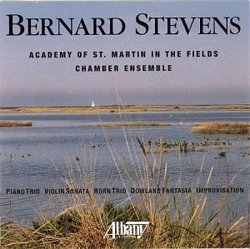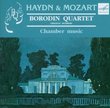| All Artists: Bernard Stevens, Hamish Milne Title: Bernard Stevens: Chamber Music Members Wishing: 0 Total Copies: 0 Label: Albany Records Original Release Date: 1/1/2003 Re-Release Date: 8/26/2003 Genre: Classical Styles: Chamber Music, Historical Periods, Classical (c.1770-1830) Number of Discs: 1 SwapaCD Credits: 1 UPC: 034061057222 |
Search - Bernard Stevens, Hamish Milne :: Bernard Stevens: Chamber Music
CD DetailsSimilar CDs |
CD ReviewsSuperb Chamber Music from a Virtually Unknown Composer J Scott Morrison | Middlebury VT, USA | 10/14/2003 (5 out of 5 stars) "Bernard Steven (b. 1916) is a British composer I'd only heard of vaguely but this CD of his music has led me to realize that he is a composer with his own voice who has written, on the basis of the violin-based chamber music on this disc, some scrumptious neoclassic music. It is no surprise that such a well-regarded group as the Academy of St. Martin in the Fields Chamber Ensemble, who could have given us yet another CD of Brahms or Mozart, has undertaken to record this unfamiliar music. It is all top-drawer stuff. The instrumental star here is Kenneth Sillito, long-time leader (concertmaster) of ASMF and first violin of the Gabrieli String Quartet; he is featured as soloist in three of the five pieces: Sonata for Violin and Piano, Op. 1 (1940), Fantasia on a Theme of Dowland for Violin and Piano, Op. 23 (1953), and Improvisation for Solo Violin, Op. 48a (1973). The other pieces are the Piano Trio, Op. 3 (1942) and Trio for Horn, Violin and Piano, Op. 38 (1966). In the more than thirty years over which these pieces were written Stevens's own voice is consistently apparent. He writes in what I would call a sweetly neo-Baroque style, by which I mean that his forms and many of his procedures are Baroque in origin, but his harmonies, voice-leading and counterpoint are primarily Romantic; further he uses some of the metric irregularities made familiar by Stravinsky who, after all, more or less invented neo-classicism early last century. This makes for a clarity of form combined with absolutely lush melodies and harmonies, and with catchy rhythms. It is like a superbly cooked meal whose presentation is crisply unfussy yet sometimes surprising, a delight for both mind and heart. The underlying impulse for Stevens seems to be melody. He writes some almost Bachian tunes, usually fairly short, often used as ostinatos that grow in importance and bury themselves in your subconscious so that when they reappear they impart that delicious 'shock of recognition.' In the Dowland piece he catches and expands on the pensiveness of that composer's sweet air (the galliard 'Can Shee Excuse') This 14-minute piece is a loose set of variations, or rather fantasies, that climax in three emotionally charged Adagios that become, consecutively, more and more like the original tune, so that the ending mirrors the simple beginning, with an overlay of gentle melancholy before a tentative attempt is made at jollity. I'm not a great fan of the horn trio; it has always seemed to me that the timbre of the horn sticks out too much in the ensemble. Still, some amazing music has been written for the combination (think of the Brahms and Ligeti Horn Trios, say) and I believe Stevens's Horn Trio belongs in that company. It has three movements, all marked Adagio but with a good deal of tempo variation, and indeed the horn has rather a prominent role. It is here played marvelously by Timothy Brown; he is, if I'm not mistaken, a brother of the well-known violinist/conductor, Iona Brown. Some of the writing seems Brittenesque, probably because there are modal harmonies and some horn mordents are similar to those in Britten's immortal Serenade for Tenor, Horn and Strings. A striking piece, this, that rises now and again to dramatic climaxes only to fall back into a musing tone. My favorite pieces, by far, are the early Piano Trio and the Violin Sonata. The pianist here is Hamish Milne, well-known for his many recordings on Hyperion, and before that on Conifer and Chandos. The sonata was written while Stevens was still a student at the Royal College of Music. It is in a single 11-minute movement with three sections corresponding more or less to those of a classical sonata. At times it is intensely rhapsodic--it was, I believe, written as a love letter to the woman who became his wife--but the middle movement is faster and contains a number of contrapuntal areas, mostly canonic. The third section's coda returns to the A minor of the opening but then ends in a bright A major. The Piano Trio, written two years after the Sonata, is probably Stevens's best-known chamber work, having been played numerous times in Britain. But I have no recollection of ever seeing it on a program here in the US. The first movement has one of those catchy ostinati mentioned above and it builds to several dramatic climaxes. There is considerable metric ingenuity in this movement (and also in the finale) and striking use is made of fanfare-like chords in the piano, later in double-stop violin and cello chords. The slow movement is a cantabile outpouring of string-song over throbbing sotto voce piano chords; it moves into the third movement without a break. The finale begins a merry variation of the first movement's main theme but then slips into a lyrical 2/4 theme against ¾ accompaniment. Then the main theme returns and all ends in a kind of brusque recapitulation as if to see 'that's all there is, there isn't any more.'I have to say that this disc came as a distinct surprise and pleasure to me. I will now be on the lookout for more of Stevens's music. I see that there are CDs of an opera and of string quartets on Albany. He definitely deserves to be heard. His voice is his own, but if I were required to compare him to any of his contemporaries I would mention Rubbra. Worth investigating. TT=67:56Scott Morrison"
|



